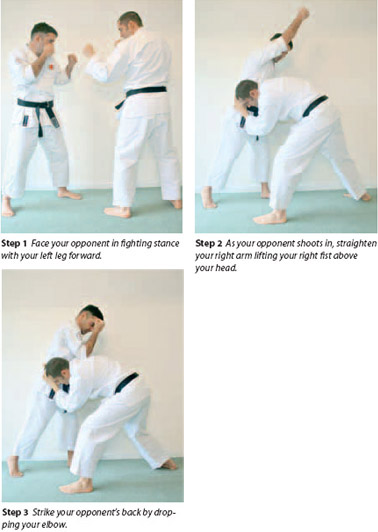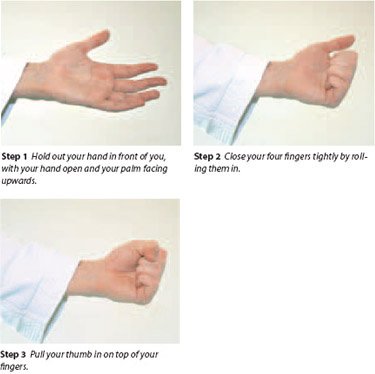
Don't hit at all if it is honorably possible to avoid hitting; but never hit softly.
~ Theodore Roosevelt
Hand and Elbow Strikes
This chapter looks at the main type of attacks that can be made using your hands and elbows. These are commonly used in karate, kung fu, boxing, and Muay Thai. The most obvious attack is of course a punch. However, there are many different types of punches and using correct technique can make the difference between hurting your opponent and hurting yourself. Punches are useful attacks only when your opponent is at arm's length. If your opponent is further away, then you would need to consider kicks. If they are closer, then you will need to look at closer range attacks, for example using your elbows or your knees.
Using the fist to strike, as you do when punching, can cause damage to the delicate bones in your hand. There are alternative methods of using your hands in attacks by using either the side of your hand, knife hand strike, or the back of your hand, as in back fist strike. Finally, your elbow can also be used for striking. The elbow strike can be used in both horizontal and vertical motions. This type of attack is very effective at close range and you are generally less likely to damage your elbow than your hand when using it for striking.
When training in these techniques you may find that you are able to perform stronger attacks on one side than the other. You should use your training practice to try to build upon your weaker side, to ensure that you can apply effective strikes from both sides of your body.
| SUMMARY OF HAND AND ELBOW STRIKES | |
| Stepping punch | A linear punch used to rapidly close in on your opponent |
| Jabbing punch | A fast, linear punch made with your leading hand |
| Hook-punch | A circular punch |
| Cross-punch | A powerful, linear punch made with your rear hand |
| Uppercut | A vertical punch, moving upwards towards the body or the chin |
| Superman-punch | A punch that is fired at the same time as you pull your knee back after a feint |
| Palm-strike | A strike particularly popular for self-defense |
| Knife hand-strike | A strike to the neck, side of head or arm using the edge of your hand |
| Reverse knife hand-strike | A strike to the neck or arm using the edge of your hand that can also be used as a parry |
| Back fist strike | A strike that whose contact point is the knuckles on your index finger and your middle finger |
| Horizontal elbow strike | A powerful circular attack using the elbow |
| Reverse horizontal elbow strike | An attack that hits with the point of the elbow |
| Uppercut elbow strike | An elbow attack that moves upwards and hits under the chin or body |
| Downward elbow strike | A dangerous finishing move to the head, collar bone, or back |
Punches
In the striking arts, punches are by far the most common upper body technique. Punches are often used by untrained fighters and are the simplest of techniques to learn. All striking arts practice punching and Western boxing is based entirely around punching. Practicing individual punches is the first step to reaching the full potential of punching, but it cannot be realized until you practice using them in combinations that chain punches together. The most common targets for punches are the head and then the torso. There are many vulnerable targets in these areas and punches can be strong, swift techniques that can attack them specifically.
MAKING A FIST
It is important to understand how to correctly make a fist before punching. If you use bad technique while punching it is likely to cause you injury. Most martial arts teach punches by practicing in the air. Once the basics have been mastered, you can then move on to practicing against a punching bag. When you train with a punching bag, it will be much more obvious if there is a problem with your technique, for example, if you are bending your wrist or not closing your fist properly. This weakness will make your actions weaker and also increase the risk of injuring yourself.
When you punch, ensure that you keep your wrist straight. Your contact point should be the knuckles of your index finger and your middle finger.
In some ways, the human hand is badly suited for striking because it contains many bones and joints that are relatively delicate. Many martial arts require that fighters wear protective equipment that offers protection for their hands. Some martial artists engage in conditioning exercises, for example plunging their hands into hot sand or punching wooden targets, in an attempt to toughen their fists. Other martial artists consider exposing their hands to this kind of trauma to be more damaging than beneficial. A weak fist or wrist can result in injury when punching. For example, if your thumb sticks out then it can inadvertently get caught and damage your thumb joint.
One way to avoid injuring your fist when punching without the need for conditioning or protective equipment is to aim for soft targets, so accurate punching is an important skill. Another option is to use a palm strike.

STEPPING PUNCH
Use the stepping punch to rapidly close in on an opponent. This can be useful in placing pressure on an opponent or pursuing a retreating opponent. This technique is often used in quick succession as a way of charging your opponent or pushing them out of the competition area. This is a popular attack in karate where it is called a pursuit punch, oi-zuki.
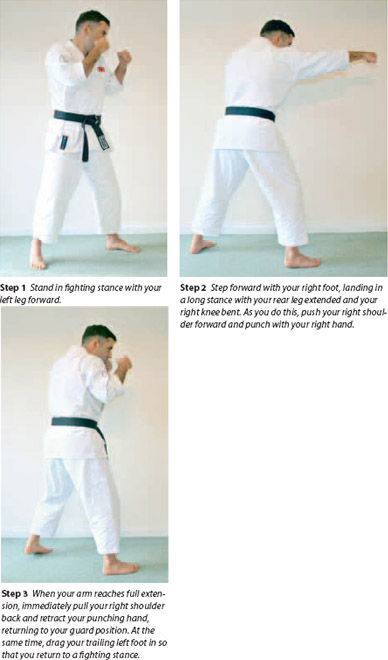
JABBING PUNCH
A jab is a fast, straight punch thrown from the front hand. What this punch lacks in power, it makes up for in speed. Because the jab requires relatively little effort to execute and carries a low risk of counter attack, you can use it to test an opponent's defenses or gauge distance to an opponent. It is also commonly used as a feint to open your opponent's guard. This is a popular attack in karate where it is called kizami-zuki.
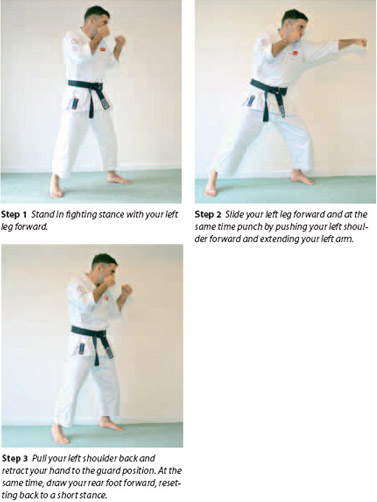
You can use a jab as an attacking move by using it simultaneously with a forward motion, often as an opening technique in an attacking combination.
You can also use the jabbing punch as a defensive technique, quickly counter striking an attacker and using the speed of an oncoming opponent to overcome any lack of power in the jab. This technique also makes use of coming off the line of the attack.
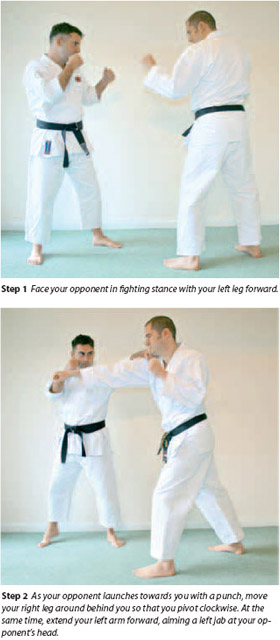
HOOK PUNCH
The hook punch uses a circular motion to land a powerful knockout blow. It is also a key punch in full contact striking arts such as boxing and Muay Thai.
A larger and more powerful version of the hook involves straightening the arm as you bring it back and then swinging in a wide circular arc at the target. This type of punch is called a “haymaker” or a “sucker punch” and, while more powerful than a hook, it is so wild and easily countered that it is rarely used by experienced fighters unless against an already stunned opponent who is unlikely to exploit this weakness.
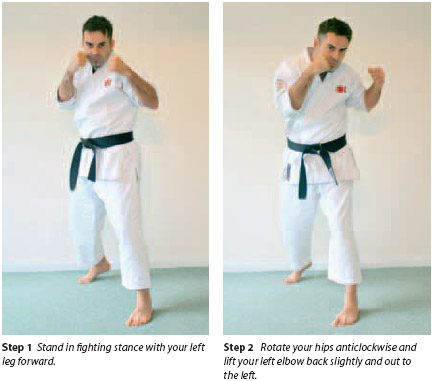

CROSS PUNCH
A cross punch, also known as a “straight,” is a straight punch thrown from the rear hand. It is a powerful punch because it uses a big rotation of the body and throws the body weight forward, but for the same reasons it is slower than throwing a jab and is prone to counter attack. Often a fighter will use what is known as a “one-two,” leading with a jabbing punch and then following up with a cross punch. In karate it is called a reverse punch, gyaku-zuki.
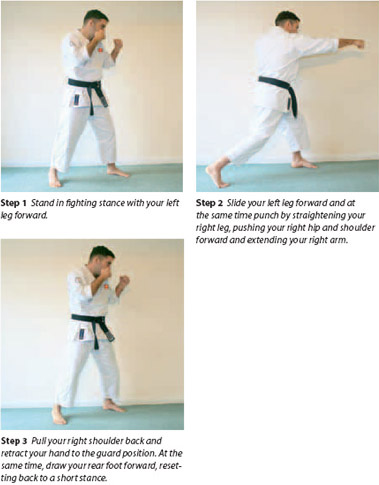
Pulling back the opposite hand when punching is a training mechanism used by karate practitioners that can help you to learn how to use your body correctly when punching and also to use the retracting hand to unbalance your opponent.
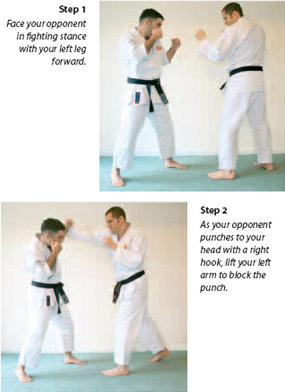

UPPERCUT
The uppercut punch is a powerful attack that travels from below its target before lifting up and hitting either the head, or if your opponent is hunched over, the body. The uppercut gets some of its power from your biceps but can also make use of your legs to get under your opponent and then lift up. This is a popular technique in boxing and Muay Thai.
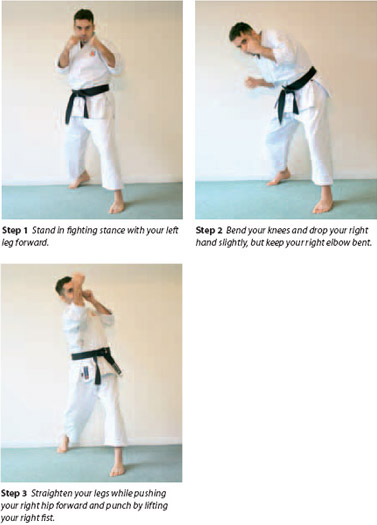
A common combination involves using an uppercut to lift an opponent's chin, leaving them open to a follow up with a hook, potentially scoring a knockout blow.
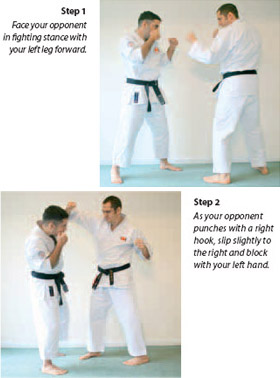

SUPERMAN PUNCH
This punching technique comes from the world of Thai boxing, and has become quite popular on the MMA scene. The superman punch works by using a fake knee strike to draw your opponent's guard down, creating an opening for the head level punch.
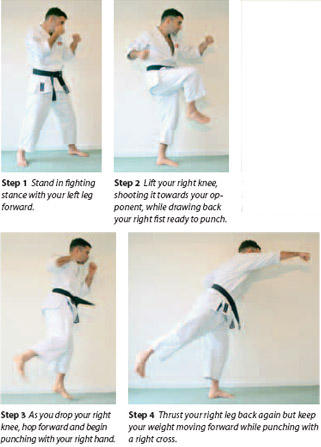
The superman punch is a bit of an all or nothing attack. If your opponent realizes what you are doing, then they can easily counter attack, but if it works then it is a very powerful attack. Before using this attack, you should lay the groundwork to give it the best chance of success. Throw some low or medium level kicking attacks so that when you begin the superman punch, your opponent will be more likely to react to the knee lift thinking it is a kick, thus creating the opening that you need.

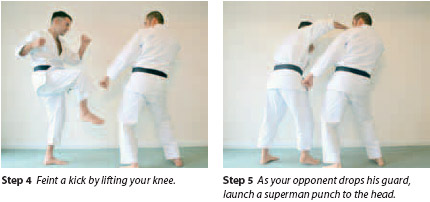
PUNCHING COMBINATIONS
A common mistake by inexperienced fighters is to throw punches in isolation. This rarely represents much of a threat to an opponent because a single punch is easily blocked or evaded and can allow an opponent the opportunity to counter attack. A series of punches thrown in combination puts an opponent under more pressure and each punch can create an opening for the subsequent punch.
You can enhance your punching combination, for example, with a strong forward motion, putting your opponent firmly into defensive mode.
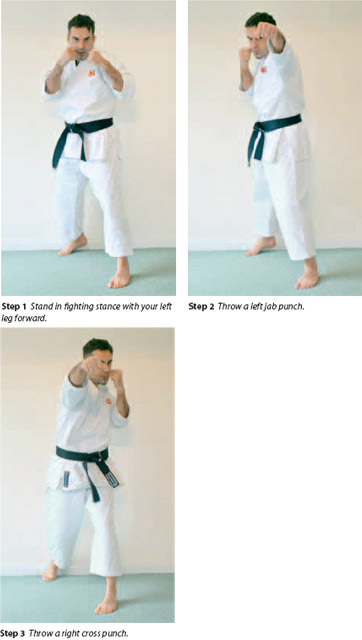

Other Hand Strikes
There are of course other parts of the hand that can be used to strike with other than your fist. Using the edge of your hand, the knuckles in a back fist strike or even the fingers or finger joints. The most common of these techniques are presented here.

PALM STRIKE
A palm strike (also known as a palm heel strike) is a hand technique that hits with the base of the palm. When punching with a closed fist there is a risk of injuring your own knuckles if you happen to hit something hard and bony. The palm strike does not suffer from this problem but still has a similar hitting power to using a closed fist. A palm strike is also less likely to cause cuts than an ungloved punch and so some competitions, for example the MMA event called Pancrase, have banned punches to the head in favor of palm strikes. It is the base of the palm that is the key contact point in this attack.
When hitting with a palm strike, bend your wrist back and pull your fingers back so that you can strike with the base of your palm.
This attack can also be used in a horizontal motion, for example, attacking the floating ribs. However, it is usually aimed at the head and, in self-defense applications, it is targeted in particular at the nose or under the chin so that the opponent's head is pushed back, allowing for follow up attacks.

KNIFE HAND STRIKE
The knife hand strike is sometimes called the sword hand strike. This is the strike that has become popularly known as the “karate chop.” In karate, it is known as shuto uchi.
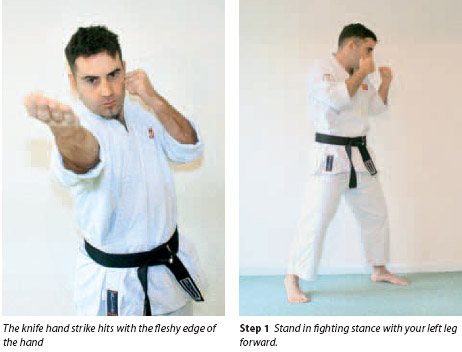

A knife hand strike can be used to strike the side of your opponent's head, with the strike moving horizontally. This strike can also be used to strike the neck, moving diagonally downwards. Since this technique is regarded as too dangerous to be allowed in competitions, it is hard to come by real life accounts of the effect of this strike. However, on the BBC television program “The Indestructibles,” a British martial artist, Terry Wingrove, demonstrated how he could knockout an opponent with a single knife hand strike to the neck. Obviously, when practicing this technique with a sparring partner, you should not attempt to reproduce this result, and so extra care should be taken to stop your strikes short of your target.
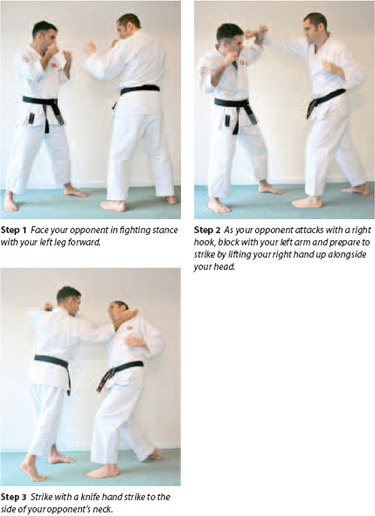
REVERSE KNIFE HAND STRIKE
In karate, this technique is often used to parry attacks and is referred to as shuto uke.
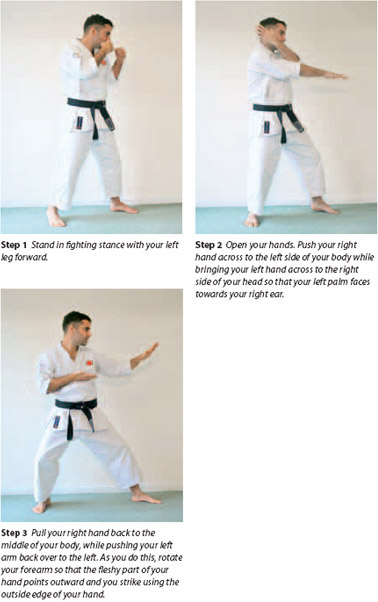
This technique is most commonly targeted at the forearm or the neck.

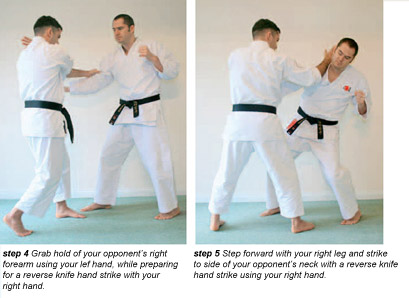
BACK FIST STRIKE
The back fist strike is most commonly used in kung fu, usually as part of a chain of hand strikes. It is also used in karate and is called uraken uchi.
It is important to hit with the knuckles of your index finger and your middle finger, rather than the delicate bones in the back of your hand. To do this you should ensure that you rotate your forearm so that these big knuckles are nearest to the target. You should also allow your wrist to flex, so that your knuckles flick towards your target.
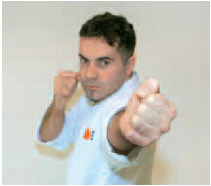
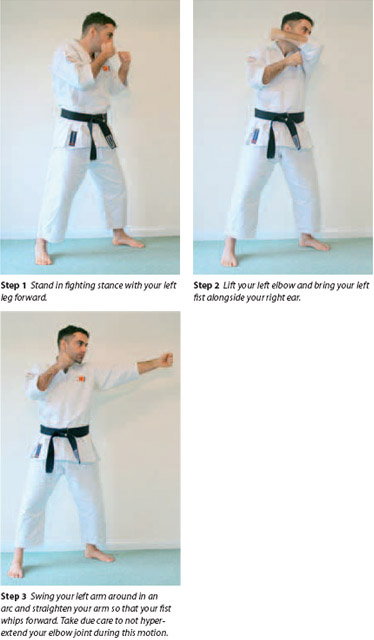
Elbow Strikes
Elbow strikes are effective short-range attacks that can be used in the grappling phase of combat. The elbow is a particularly bony and tough part of the body and so can be used for heavy strikes against a great many target areas. Elbow strikes tend to cause your opponent cuts, especially when you hit the face, so many martial arts forbid the use of elbows in competitions. In contests where they are allowed, for example MMA and Muay Thai fights, they are often used specifically because they can give cuts which can bring a fight to an end with a technical knockout (TKO).
HORIZONTAL ELBOW STRIKE
In Muay Thai, the horizontal elbow strike is called sok tad. In karate, it is called a circular elbow strike, mawashi empi uchi. This powerful attack is usually aimed at the head but can also be used as a body blow. It can be used during the grappling phase of combat as well as during ground fighting.
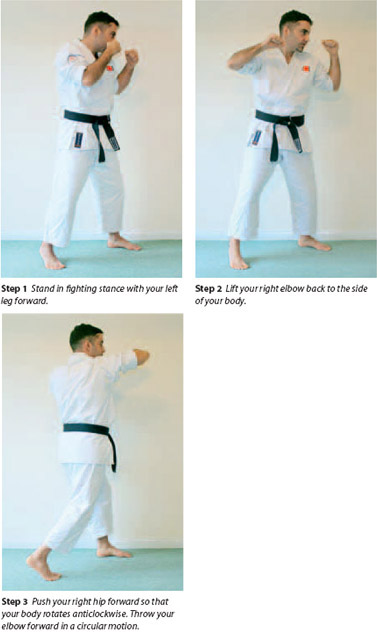
If you try using a horizontal elbow strike when your opponent is in the punching range, it is more than likely to be easily blocked. Even so, there is a chance that it may still be effective, because the elbow strike is powerful and a weak block may well collapse. However, this elbow strike is best used when already at close range during the grappling phase of combat.
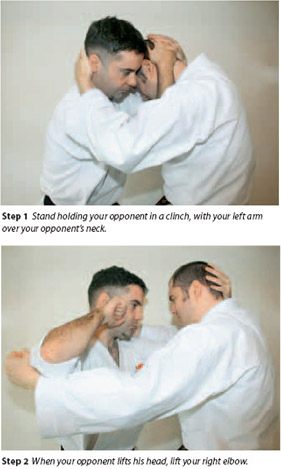

In Muay Thai, a common variation of the horizontal elbow strike is the slashing elbow, sok ti. This is performed in the same way as the horizontal elbow but, instead of travelling parallel to the ground, the elbow starts high up and then slashes diagonally down and across.
REVERSE HORIZONTAL ELBOW STRIKE
In Muay Thai, the reverse horizontal elbow is called sok klab. In karate, it is called a side elbow strike, yoko empi uchi.
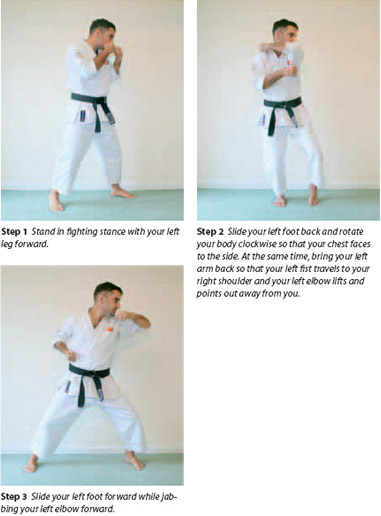
You can use the reverse horizontal elbow in combination with the horizontal elbow strike during the grappling phase of combat.
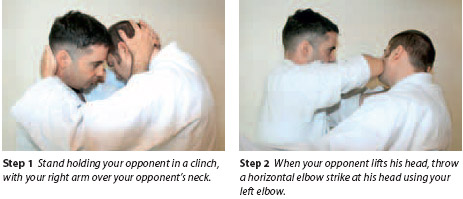
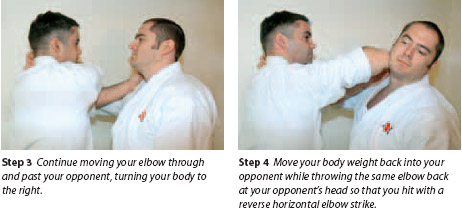
UPPERCUT ELBOW
In Muay Thai, the uppercut elbow strike is called sok kun. In karate, it is called a rising elbow strike, age empi uchi. It is a close range attack that can be used in the grappling phase of combat.
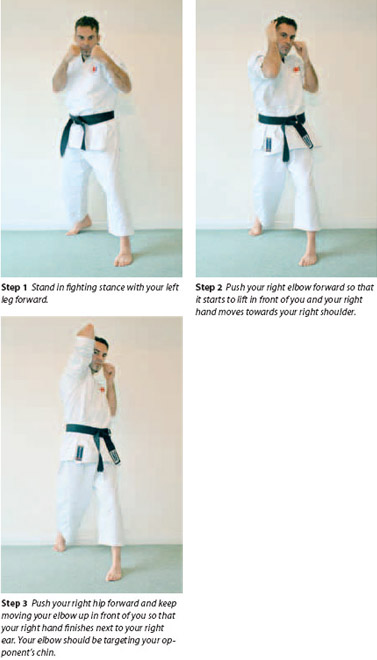
In karate, a closed fist is a common technique, but in Muay Thai it is usually done with an open hand, mainly because the big gloves worn in sparring would get in the way as your hand passes your head and opening the hand avoids this.
The uppercut elbow can be used as a bold counter striking technique that involves driving forward into your opponent.
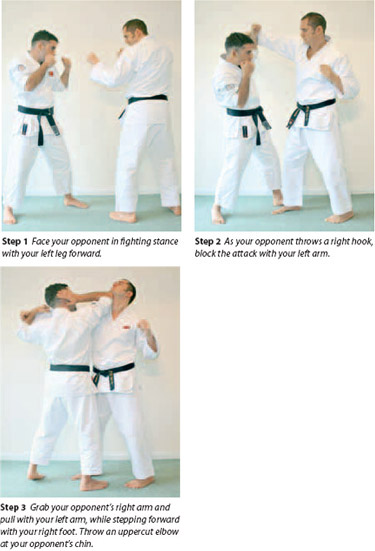
DOWNWARD ELBOW STRIKE
Also known as the "straight 12-6" dropping elbow or spiking downward elbow. This technique strikes with the point of the elbow in a downward direction. Possible targets include the top of the head, the nose, the clavicle (collar bone) or the spine, depending on the position of your opponent at the time. It is important to note that the spine is a very dangerous target to strike and should only be considered a possibility in a life or death self-defense situation. Consequently, this sort of attack tends to be banned in competitions.

One use of this technique is to attack an opponent attempting to shoot in take you down by grabbing your legs. When practicing this with a sparring partner, be sure to stop the elbow strike short of your opponent so as to avoid an injury.
